Monitor lizards are part of a genus of large lizards found in Africa, Asia, and Oceania. Although most people think of the Komodo dragon when speaking about these reptiles, they’re only the most famous type and not a good measure of the whole genus.
Other species exist, and they’re smaller and less capable of fending off threats in most cases. However, these lizards share a range with many other deadly creatures, like venomous snakes. Imagine that a king cobra vs monitor lizard fight breaks out over food. Which animal would win in a battle?
We’re going to break down this potential battle and show you which of these animals has what it takes to survive a fight. Learn which reptile has the advantages needed to slither or scurry away as the winner!
Comparing a King Cobra and a Monitor Lizard
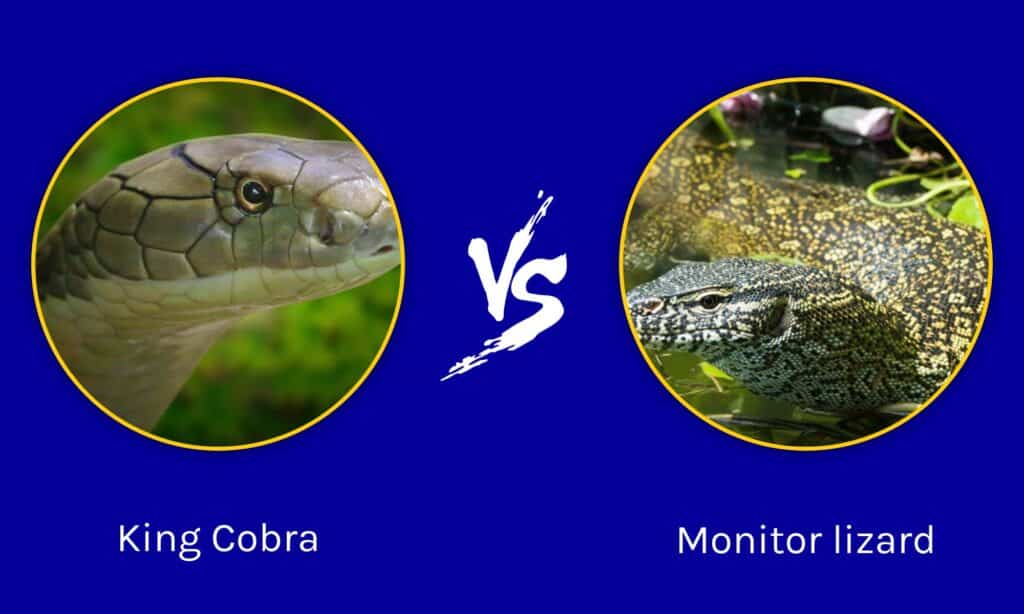
| King Cobra | Monitor Lizard | |
|---|---|---|
| Size | Weight: 10lbs-20lbs Length: 10ft-19ft | Weight: 2.2-366lbs Length: 0.6 ft-10 ft |
| Speed and Movement Type | – 12 mph – Slithering along the ground | – Up to 28 mph – Crawls with diagonally opposite feet simultaneously |
| Defenses | – Large size – Threat display makes predators hesitate – Aposematic markings on its hood – Ability to hide in relatively small areas | – Speed – Osteoderms in their skin – Tough, scaly skin |
| Offensive Capabilities | – Will lift the front of its body several feet from the ground and then strike, allowing it to deliver venom in the vital areas – Fangs that measure 0.5 in – Long fangs deliver up to 1000mg of venom – A single bite can kill 11 humans | – Partially venomous in some species – Uses short, sharp teeth to bite and tear their prey – Will often use their full body weight to drag prey down – Have sharp claws for digging into prey – May also use a tail whip to be disorienting or trip enemies |
| Predatory Behavior | – Ambush predator | – Active, opportunistic hunters – Ambush predators |
What Are Key Differences Between a King Cobra and a Monitor Lizard?
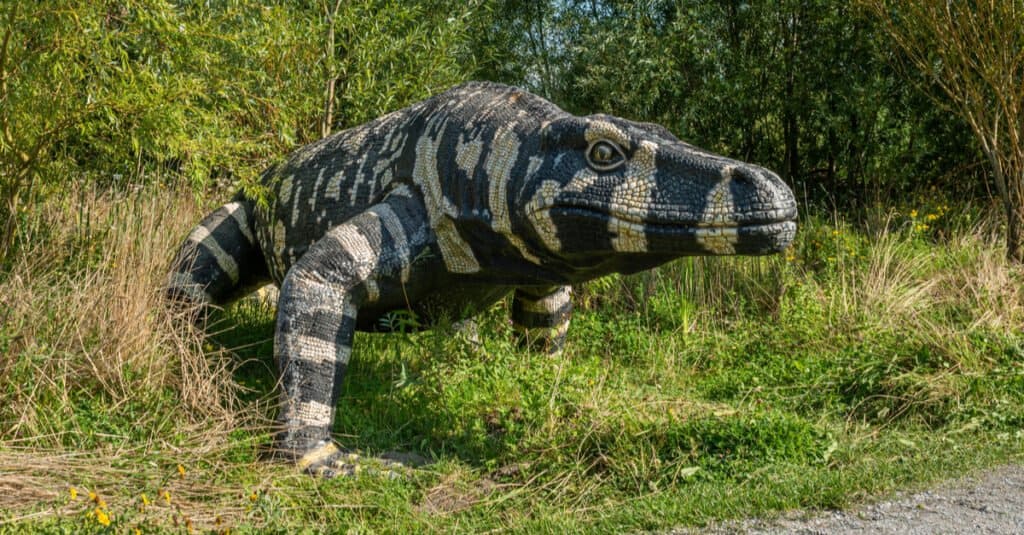
Monitor lizards crawl on the ground and vary greatly in size.
©Erik Laan/Shutterstock.com
The greatest differences between a king cobra and a monitor lizard include their size, form of locomotion, and the way they kill their prey. King cobras can grow up to 19 ft long and weigh 20 lbs, move by slithering on the ground, and kill their prey with a powerful venom. Monitor lizards can measure anywhere from 8 inches long to 10 ft long, weigh anywhere from 2 to 366 lbs, quickly crawl along the ground, and kill their prey with brutal, tearing bites.
These differences in their form and methods of attack show the potency of these creatures. However, they also show areas in which one animal could gain an advantage over the other. We’re going to explore those advantages and disadvantages through the lens of key factors in the following section.
What Are the Key Factors in a Fight Between a King Cobra and a Monitor Lizard?

Venom, speed, and size all come into play during this battle.
©Kletr/Shutterstock.com
Most fights in the animal kingdom come down to a relatively small series of key factors, and this battle is no different. In this case, the most significant factors are going to be the size and offensive capabilities. The size of a monitor lizard can vary quite a bit, so these reptiles may find themselves at a bad size disadvantage.
Either way, we’re going to look at five different overarching factors for this battle and show you which creature has the advantage and how each facet of their being comes into play during the battle.
King Cobra vs Monitor Lizard: Size
The king cobra often has a length advantage and a weight disadvantage against the most common monitor lizards in their range, the Bengal monitor. These monitor lizards can measure nearly 6 ft long and weigh about 16 pounds on average. That means the lizard is shorter and barely heavier than a large king cobra. However, many other small monitor lizards exist, and a few larger ones do, too.
Given that the Bengal monitor is probably the one a king cobra has the best chance of encountering, we’re going to call this section a tie.
King Cobra vs Monitor Lizard: Speed and Movement
Monitor lizards move faster than king cobras. Many monitor lizards can achieve speeds greater than 12 mph. They crawl using diagonally opposite feet, and they can scamper quite fast to bring down prey.
However, king cobras can only move at speeds of about 12 mph, and that’s not a speed they can stay at for very long. After all, they slither along the ground instead of crawling.
The monitor lizard has the speed advantage in outright movement speed.
King Cobra vs Monitor Lizard: Defenses
A monitor lizard’s defenses are rather straightforward. For example, they use their speed to run away from problems they can’t handle, have osteoderms in their skin to lessen the impact of blows, and have tough, scaly skin to prevent cuts.
The king cobra also has interesting defenses, but they’re not related to a tough body. Certainly, the large size of the snake makes them less of a target. However, the snake’s ability to hide from predators in small burrows keeps it safe, too. Lastly, they have aposematic markings on their hood, and these colors let other creatures know that they should not mess with this snake.
All in all, the monitor lizard has better defenses than the king cobra.
King Cobra vs Monitor Lizard: Offensive Capabilities
The monitor lizard is an interesting creature in terms of offensive capabilities. The larger, more violent lizards have no problem running down prey and biting it to death. They rip and tear with small, sharp teeth while digging in with their claws and using their body weight to drag down foes.
Moreover, some species are partially venomous. Their venom helps induce shock and exsanguination. These lizards can also use their tail as an offensive weapon, delivering a powerful thwack to enemies to help knock them down.
The king cobra’s offensive prowess is all about their venom. Not only are king cobras one of the deadliest venomous snakes, but they can deliver a massive amount of venom to vital areas. King cobras can lift a large portion of their body off the ground, so they can deliver strikes to the neck and head of tall animals, even humans!
King cobras bite and hold their prey in their jaws, injecting as much cytotoxic venom as possible to overwhelm them until they die. A fast-acting animal can counterattack the snake, but the fight is usually over in minutes.
King cobras have the offensive advantage in this case, especially against most monitor lizards.
King Cobra vs Monitor Lizard: Predatory Behavior
The king cobra is an ambush predator, but they may end up having to pursue their prey after they bite. Sometimes, they bite and are large enough to hold the prey in place while the venom works. Still, the instincts of most prey caught by surprise tell them to flee the area. The cobra has to bite and wait or bite and hold the prey if possible.
The monitor lizard is an active, opportunistic predator most of the time, but it can also be an ambush predator.
King cobras have the advantage in terms of predator behavior because the first strike in this fight matters quite a bit.
Who Would Win in a Fight Between a King Cobra and a Monitor Lizard?
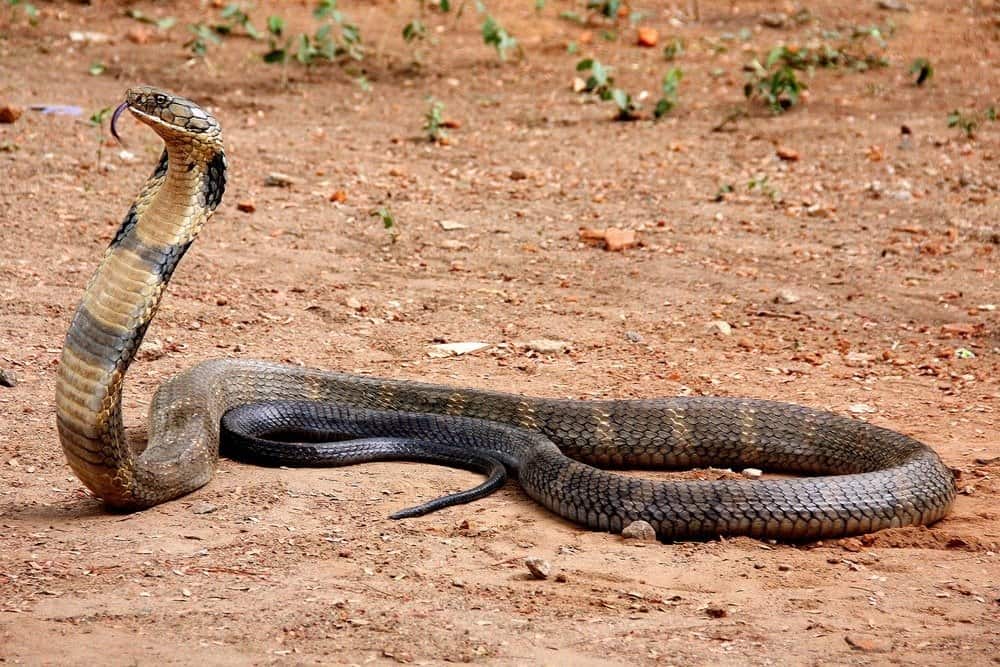
King cobras are hard to overcome in battle.
©Jolly Therattil/Shutterstock.com
A king cobra would win a fight against a monitor lizard. In the past, we’ve said that the Komodo dragon, a type of monitor lizard, would win a fight against a king cobra. Yet, we’re talking about the majority of monitor lizards, from the small ones to the sizeable Bengal monitor that lives with the king cobra in India.
In the majority of cases, the average monitor lizard is going to be too small or too slow to react to defeat the king cobra. Once the cobra bites the monitor lizard, a timer until its death begins. Sure, a big monitor lizard could potentially fight back. It may even grab the king cobra by the head and bite down, but the chances that it lands the first and only killing blow in this fight are small.
Meanwhile, King Cobras can launch an ambush and then trail the monitor lizard while it succumbs to its poison. If we look at the available cases, king cobras frequently kill monitor lizards in the wild, but the reverse is extremely rare.
The fight would begin and end with a venomous bite, and the monitor lizard would probably try to flee to save itself. It would get a lead on the king cobra, but only for a little while. The venom would bring it down and the snake would earn a meal.
What Animal Could Take Down a King Cobra?
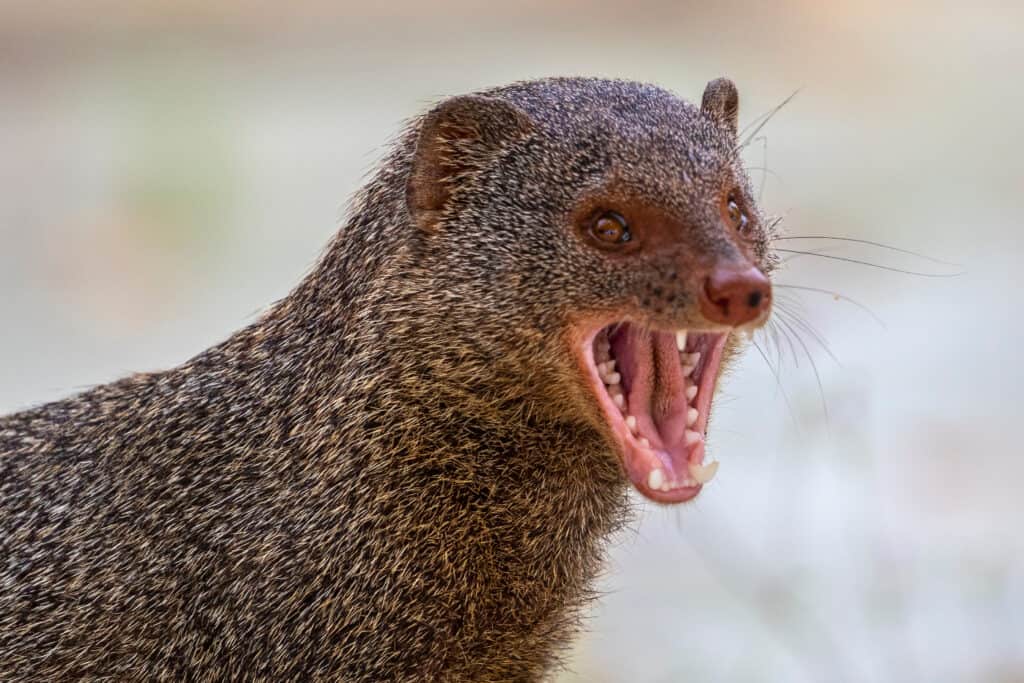
Mongooses are immune to king cobra venom and are also protected from its fangs by their fur and thick, loose skin
©Rajeev Amaratunga/Shutterstock.com
Its potent venom and speed, are key factors that enable the king cobra to efficiently dispatch its foes in the wild. Hence, it would take an adversary gifted with lightning-fast reflexes and immunity to the deadly poison injected by those fangs to be able to take on the king cobra.
Enter the mongoose, a feliform capable of ticking both boxes and which is incidentally, also partial to the reptile, as a meal option. Somewhat reminiscent of a heavier ferret with a more upright stance and a narrower snout, this carnivore is capable of taking on the fearsome predator owing to a mutation that prevents the king cobra’s venom from binding to receptors in its body and taking effect.
Additional protection also includes its thick, rigid, fur and its thick, loose, skin. The mongoose’s key strategy involves enticing the king cobra to strike several times wearying itself in the process. And then it is the mammal’s time to strike. It does so by aiming for the throat or the head instantly incapacitating the reptile. A truly effective strategy has seen employed to eliminate snakes and pests.
Can a Monitor Lizard Withstand a Cobra Bite?
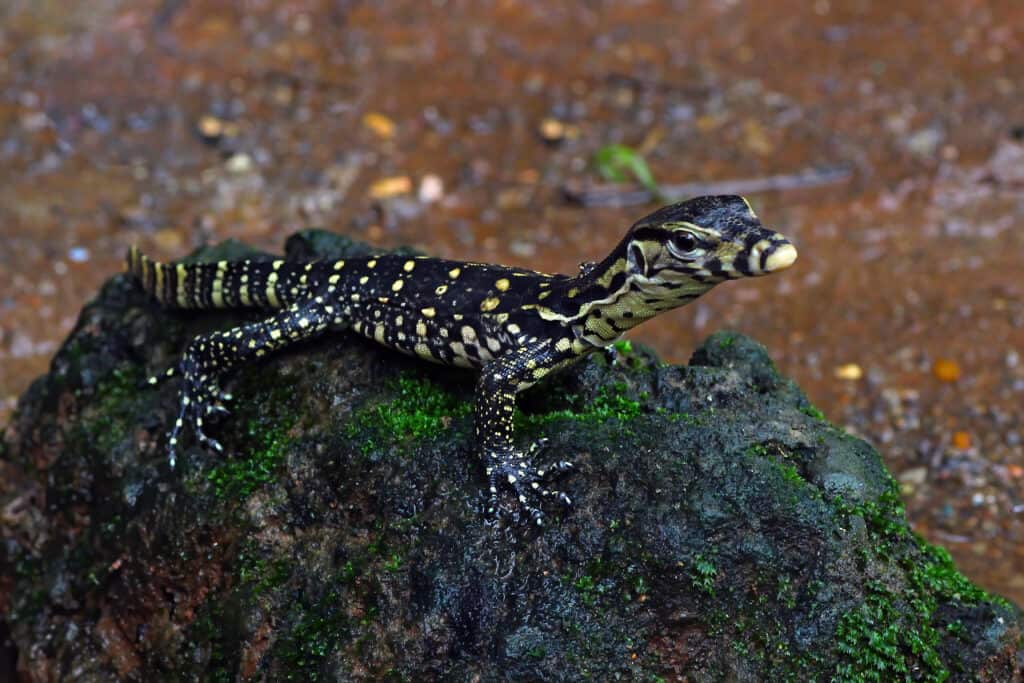
Monitor lizards can withstand a King Cobra snake bite.
©Agus_Gatam/Shutterstock.com
It’s relatively common for snouted cobras to prey on rock monitors. However, since the lizard lacks any natural immunity to snake venom, it’s improbable that it would survive such an encounter.
King cobras employ a biting strategy where they sink their fangs into their prey and maintain a firm grip, injecting a significant amount of cytotoxic venom to incapacitate their victim until it succumbs.
While some swift animals may attempt to counterattack the snake, these confrontations typically conclude within minutes. In such encounters, king cobras possess the upper hand, especially when facing the majority of monitor lizards.
The photo featured at the top of this post is © iStock.com/takeo1775
Thank you for reading! Have some feedback for us? Contact the AZ Animals editorial team.






